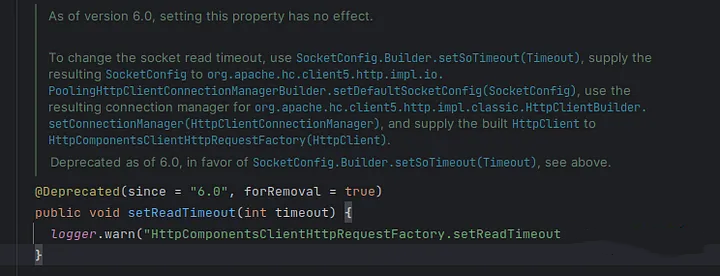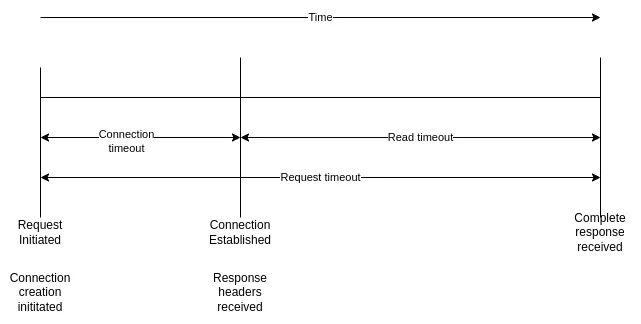弃用 RestTemplate,来了解一下官方推荐的 WebClient !
在 Spring Framework 5.0 及更高版本中,RestTemplate 已被弃用,取而代之的是较新的 WebClient。这意味着虽然 RestTemplate 仍然可用,但鼓励 Spring 开发人员迁移到新项目的 WebClient。
WebClient 优于 RestTemplate 的原因有几个:
-
非阻塞 I/O:WebClient 构建在 Reactor 之上,它提供了一种非阻塞、反应式的方法来处理 I/O。这可以在高流量应用程序中实现更好的可扩展性和更高的性能。
-
函数式风格:WebClient 使用函数式编程风格,可以使代码更易于阅读和理解。它还提供了流畅的 API,可以更轻松地配置和自定义请求。
-
更好地支持流式传输:WebClient 支持请求和响应正文的流式传输,这对于处理大文件或实时数据非常有用。
-
改进的错误处理:WebClient 提供比 RestTemplate 更好的错误处理和日志记录,从而更轻松地诊断和解决问题。
重点:即使升级了spring web 6.0.0版本,也无法在HttpRequestFactory中设置请求超时,这是放弃使用 RestTemplate 的最大因素之一。

设置请求超时不会有任何影响
总的来说,虽然 RestTemplate 可能仍然适用于某些用例,但 WebClient 提供了几个优势,使其成为现代 Spring 应用程序的更好选择。
让我们看看如何在 SpringBoot 3 应用程序中使用 WebClient。
(1) 创建网络客户端:
import io.netty.channel.ChannelOption;
import io.netty.channel.ConnectTimeoutException;
import io.netty.handler.timeout.ReadTimeoutException;
import io.netty.handler.timeout.ReadTimeoutHandler;
import io.netty.handler.timeout.TimeoutException;
import jakarta.annotation.PostConstruct;
import java.time.Duration;
import org.slf4j.Logger;
import org.slf4j.LoggerFactory;
import org.springframework.beans.factory.annotation.Value;
import org.springframework.http.HttpMethod;
import org.springframework.http.MediaType;
import org.springframework.http.client.reactive.ReactorClientHttpConnector;
import org.springframework.stereotype.Service;
import org.springframework.web.reactive.function.client.WebClient;
import org.springframework.web.reactive.function.client.WebClientRequestException;
import org.springframework.web.reactive.function.client.WebClientResponseException;
import reactor.core.publisher.Mono;
import reactor.netty.http.client.HttpClient;HttpClient httpClient =HttpClient.create().option(ChannelOption.CONNECT_TIMEOUT_MILLIS, connectionTimeout).responseTimeout(Duration.ofMillis(requestTimeout)).doOnConnected(conn -> conn.addHandlerLast(new ReadTimeoutHandler(readTimeout)));WebClient client =WebClient.builder().clientConnector(new ReactorClientHttpConnector(httpClient)).build();
(2) 同步发送请求(就像RestTemplate一样)
如果你想坚持使用发送 HTTP 请求并等待响应的老方法,也可以使用 WebClient 实现如下所示的相同功能:
public String postSynchronously(String url, String requestBody) {LOG.info("Going to hit API - URL {} Body {}", url, requestBody);String response = "";try {response =client.method(HttpMethod.POST).uri(url).accept(MediaType.ALL).contentType(MediaType.APPLICATION_JSON).bodyValue(requestBody).retrieve().bodyToMono(String.class).block();} catch (Exception ex) {LOG.error("Error while calling API ", ex);throw new RunTimeException("XYZ service api error: " + ex.getMessage());} finally {LOG.info("API Response {}", response);}return response;
}
block()用于同步等待响应,这可能并不适合所有情况,你可能需要考虑subscribe()异步使用和处理响应。
(3) 异步发送请求:
有时我们不想等待响应,而是希望异步处理响应,这可以按如下方式完成:
import org.springframework.http.MediaType;
import org.springframework.web.reactive.function.BodyInserters;
import org.springframework.web.reactive.function.client.WebClient;
import reactor.core.publisher.Mono;public static Mono<String> makePostRequestAsync(String url, String postData) {WebClient webClient = WebClient.builder().build();return webClient.post().uri(url).contentType(MediaType.APPLICATION_FORM_URLENCODED).body(BodyInserters.fromFormData("data", postData)).retrieve().bodyToMono(String.class);
}
要使用此函数,只需传入要向其发送 POST 请求的 URL 以及要在请求正文中以 URL 编码字符串形式发送的数据。该函数将返回来自服务器的响应,或者如果请求由于任何原因失败,则返回一条错误消息。
请注意,在此示例中,WebClient是使用默认配置构建的。你可能需要根据不同要求进行不同的配置。
另请注意,block()用于同步等待响应,这可能并不适合所有情况。你可能需要考虑subscribe()异步使用和处理响应。
要使用响应,您可以订阅Mono并异步处理响应。下面是一个例子:
makePostRequestAsync( "https://example.com/api" , "param1=value1¶m2=value2" )
.subscribe(response -> { // 处理响应System.out.println ( response );
}, error -> { / / 处理错误System.err.println ( error .getMessage ()); }
);
subscribe()用于异步处理响应,你可以提供两个 lambda 表达式作为 subscribe() 的参数。如果请求成功并收到响应作为参数,则执行第一个 lambda 表达式;如果请求失败并收到错误作为参数,则执行第二个 lambda 表达式。
(4) 处理4XX和5XX错误:
import org.springframework.http.HttpStatus;
import org.springframework.http.MediaType;
import org.springframework.web.reactive.function.BodyInserters;
import org.springframework.web.reactive.function.client.WebClient;
import reactor.core.publisher.Mono;public static Mono<String> makePostRequestAsync(String url, String postData) {WebClient webClient = WebClient.builder().baseUrl(url).build();return webClient.post().uri("/").contentType(MediaType.APPLICATION_FORM_URLENCODED).body(BodyInserters.fromFormData("data", postData)).retrieve().onStatus(HttpStatus::is4xxClientError, clientResponse -> Mono.error(new RuntimeException("Client error"))).onStatus(HttpStatus::is5xxServerError, clientResponse -> Mono.error(new RuntimeException("Server error"))).bodyToMono(String.class);
}
在此示例中,该onStatus()方法被调用两次,一次针对 4xx 客户端错误,一次针对 5xx 服务器错误。onStatus() 每次调用都采用两个参数:
-
aPredicate确定错误状态代码是否与条件匹配
-
aFunction用于返回Mono,即要传播到订阅者的错误信息。
如果状态代码与条件匹配,Mono则会发出相应的状态代码,并且Mono链会因错误而终止。在此示例中,Mono 将发出一条 RuntimeException 错误消息,指示该错误是客户端错误还是服务器错误。
(5) 根据错误状态采取行动:
要根据Mono的subscribe()方法中的错误采取操作,可以在subscribe函数中处理响应的lambda表达式之后添加另一个lambda表达。如果在处理Monumber的过程中出现错误,则执行第二个lambda表达式。
下面是如何使用makePostRequestAsync函数和处理subscribe方法中的错误的更新示例:
makePostRequestAsync("https://example.com/api", "param1=value1¶m2=value2")
.subscribe(response -> {// handle the responseSystem.out.println(response);
}, error -> {// handle the errorSystem.err.println("An error occurred: " + error.getMessage());if (error instanceof WebClientResponseException) {WebClientResponseException webClientResponseException = (WebClientResponseException) error;int statusCode = webClientResponseException.getStatusCode().value();String statusText = webClientResponseException.getStatusText();System.err.println("Error status code: " + statusCode);System.err.println("Error status text: " + statusText);}
});
subscribe方法中的第二个lambda表达式检查错误是否是WebClientResponseException的实例,这是WebClient在服务器有错误响应时抛出的特定类型的异常。如果它是WebClientResponseException的实例,则代码将从异常中提取状态代码和状态文本,并将它们记录到日志中。
还可以根据发生的特定错误在此lambda表达式中添加其他错误处理逻辑。例如,你可以重试请求、回退到默认值或以特定方式记录错误。
(6) 处理成功响应和错误的完整代码:
responseMono.subscribe(
response -> {// handle the responseLOG.info("SUCCESS API Response {}", response);
},
error -> {// handle the errorLOG.error("An error occurred: {}", error.getMessage());LOG.error("error class: {}", error.getClass());// Errors / Exceptions from Serverif (error instanceof WebClientResponseException) {WebClientResponseException webClientResponseException =(WebClientResponseException) error;int statusCode = webClientResponseException.getStatusCode().value();String statusText = webClientResponseException.getStatusText();LOG.info("Error status code: {}", statusCode);LOG.info("Error status text: {}", statusText);if (statusCode >= 400 && statusCode < 500) {LOG.info("Error Response body {}", webClientResponseException.getResponseBodyAsString());}Throwable cause = webClientResponseException.getCause();LOG.error("webClientResponseException");if (null != cause) {LOG.info("Cause {}", cause.getClass());if (cause instanceof ReadTimeoutException) {LOG.error("ReadTimeout Exception");}if (cause instanceof TimeoutException) {LOG.error("Timeout Exception");}}}// Client errors i.e. Timeouts etc - if (error instanceof WebClientRequestException) {LOG.error("webClientRequestException");WebClientRequestException webClientRequestException =(WebClientRequestException) error;Throwable cause = webClientRequestException.getCause();if (null != cause) {LOG.info("Cause {}", cause.getClass());if (cause instanceof ReadTimeoutException) {LOG.error("ReadTimeout Exception");}if (cause instanceof ConnectTimeoutException) {LOG.error("Connect Timeout Exception");}}}
});
超时
我们可以在每个请求中设置超时,如下所示:
return webClient.method(this.httpMethod).uri(this.uri).headers(httpHeaders -> httpHeaders.addAll(additionalHeaders)).bodyValue(this.requestEntity).retrieve().bodyToMono(responseType).timeout(Duration.ofMillis(readTimeout)) // request timeout for this request.block();
但是,我们无法在每个请求中设置连接超时,这是WebClient 的属性,只能设置一次。如果需要,我们始终可以使用新的连接超时值创建一个新的 Web 客户端实例。
连接超时、读取超时和请求超时的区别如下:

结论
由于 RestTemplace 已弃用,开发人员应开始使用 WebClient 进行 REST 调用,非阻塞 I/O 调用肯定会提高应用程序性能。它不仅提供了许多其他令人兴奋的功能,例如改进的错误处理和对流的支持,而且如果需要,它还可以在阻塞模式下使用来模拟 RestTemplate 行为。
